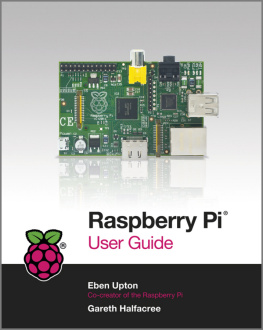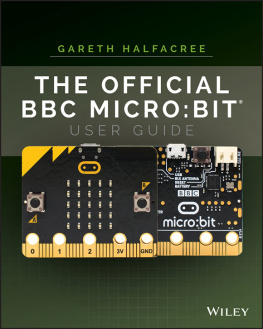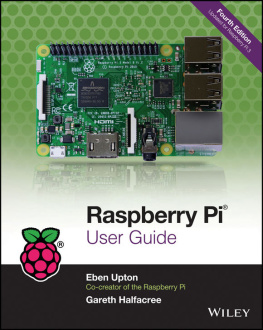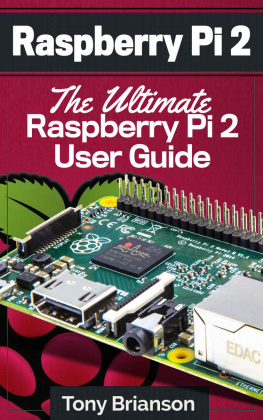Halfacree - Raspberry Pi User Guide
Here you can read online Halfacree - Raspberry Pi User Guide full text of the book (entire story) in english for free. Download pdf and epub, get meaning, cover and reviews about this ebook. year: 2013, publisher: John Wiley & Sons, genre: Home and family. Description of the work, (preface) as well as reviews are available. Best literature library LitArk.com created for fans of good reading and offers a wide selection of genres:
Romance novel
Science fiction
Adventure
Detective
Science
History
Home and family
Prose
Art
Politics
Computer
Non-fiction
Religion
Business
Children
Humor
Choose a favorite category and find really read worthwhile books. Enjoy immersion in the world of imagination, feel the emotions of the characters or learn something new for yourself, make an fascinating discovery.
Raspberry Pi User Guide: summary, description and annotation
We offer to read an annotation, description, summary or preface (depends on what the author of the book "Raspberry Pi User Guide" wrote himself). If you haven't found the necessary information about the book — write in the comments, we will try to find it.
Raspberry Pi User Guide — read online for free the complete book (whole text) full work
Below is the text of the book, divided by pages. System saving the place of the last page read, allows you to conveniently read the book "Raspberry Pi User Guide" online for free, without having to search again every time where you left off. Put a bookmark, and you can go to the page where you finished reading at any time.
Font size:
Interval:
Bookmark:

Raspberry Pi User Guide
Eben Upton and Gareth Halfacree

Raspberry Pi User Guide
This edition first published 2012
2012 Eben Upton and Gareth Halfacree
Registered office
John Wiley & Sons Ltd., The Atrium, Southern Gate, Chichester, West Sussex, PO19 8SQ, United Kingdom
For details of our global editorial offices, for customer services and for information about how to apply for permission to reuse the copyright material in this book please see our website at www.wiley.com.
The right of the authors to be identified as the authors of this work has been asserted in accordance with the Copyright, Designs and Patents Act 1988.
All rights reserved. No part of this publication may be reproduced, stored in a retrieval system, or transmitted, in any form or by any means, electronic, mechanical, photocopying, recording or otherwise, except as permitted by the UK Copyright, Designs and Patents Act 1988, without the prior permission of the publisher.
Wiley also publishes its books in a variety of electronic formats. Some content that appears in print may not be available in electronic books.
Designations used by companies to distinguish their products are often claimed as trademarks. All brand names and product names used in this book are trade names, service marks, trademarks or registered trademarks of their respective owners. The publisher is not associated with any product or vendor mentioned in this book. This publication is designed to provide accurate and authoritative information in regard to the subject matter covered. It is sold on the understanding that the publisher is not engaged in rendering professional services. If professional advice or other expert assistance is required, the services of a competent professional should be sought.
Trademarks: Wiley and the Wiley logo are trademarks or registered trademarks of John Wiley and Sons, Ltd. and/or its affiliates in the United States and/or other countries, and may not be used without written permission. Raspberry Pi and the Raspberry Pi logo are registered trademarks of the Raspberry Pi Foundation. All other trademarks are the property of their respective owners. John Wiley & Sons, Ltd. is not associated with any product or vendor mentioned in the book.
Google Drive is a registered trademark of Google.
A catalogue record for this book is available from the British Library.
ISBN 978-1-118-46446-5 (pbk); ISBN 978-1-118-46448-9 (ebk); ISBN 978-1-118-46447-2 (ebk); ISBN 978-1-118-46449-6 (ebk)
Set in 10 pt. Chaparral Pro by Indianapolis Composition Services
Printed simultaneously in Great Britain and the United States
Publishers Acknowledgements
Some of the people who helped bring this book to market include the following:
Editorial and Production
VP Consumer and Technology Publishing Director
Michelle Leete
Associate DirectorBook Content Management
Martin Tribe
Associate Publisher
Chris Webb
Executive Commissioning Editor
Craig Smith
Assistant Editor
Ellie Scott
Project Editor
Kathryn Duggan
Copy Editor
Kathryn Duggan
Technical Editor
Omer Kilic
Editorial Manager
Jodi Jensen
Senior Project Editor
Sara Shlaer
Editorial Assistant
Leslie Saxman
Marketing
Associate Marketing Director
Louise Breinholt
Marketing Manager
Lorna Mein
Senior Marketing Executive
Kate Parrett
Composition Services
Compositor
Erin Zeltner
Proofreader
Wordsmith Editorial
Indexer
BIM Indexing & Proofreading Services
About the Authors
Eben Upton is a founder and trustee of the Raspberry Pi Foundation, and serves as its Executive Director. He is responsible for the overall software and hardware architecture of the Raspberry Pi, and for the Foundation's relationships with its key suppliers and customers. In an earlier life, he founded two successful mobile games and middleware companies, Ideaworks 3d Ltd. and Podfun Ltd., and held the post of Director of Studies for Computer Science at St John's College, Cambridge. He holds a BA, a PhD and an MBA from the University of Cambridge.
In his day job, Eben works for Broadcom as an ASIC architect and general troublemaker.
Gareth Halfacree is a freelance technology journalist and the co-author of the Raspberry Pi User Guide alongside project co-founder Eben Upton. Formerly a system administrator working in the education sector, Gareths passion for open source projects has followed him from one career to another, and he can often be seen reviewing, documenting or even contributing to projects including GNU/Linux, LibreOffice, Fritzing and Arduino. He is also the creator of the Sleepduino and Burnduino open hardware projects, which extend the capabilities of the Arduino electronics prototyping system. A summary of his current work can be found at http://freelance.halfacree.co.uk.
For Liz, who made it all possible.
Eben
For my father, the enthusiastic past, and my daughter, the exciting future.
Gareth
Introduction
Children today are digital natives, said a man I got talking to at a fireworks party last year. I dont understand why youre making this thing. My kids know more about setting up our PC than I do.
I asked him if they could program, to which he replied: Why would they want to? The computers do all the stuff they need for them already, dont they? Isnt that the point?
As it happens, plenty of kids today arent digital natives. We have yet to meet any of these imagined wild digital children, swinging from ropes of twisted-pair cable and chanting war songs in nicely parsed Python. In the Raspberry Pi Foundations educational outreach work, we do meet a lot of kids whose entire interaction with technology is limited to closed platforms with graphical user interfaces (GUIs) that they use to play movies, do a spot of word-processed homework and play games. They can browse the web, upload pictures and video, and even design web pages. (Theyre often better at setting the satellite TV box than Mum or Dad, too.) Its a useful toolset, but its shockingly incomplete, and in a country where 20% of households still dont have a computer in the home, even this toolset is not available to all children.
Despite the most fervent wishes of my new acquaintance at the fireworks party, computers dont program themselves. We need an industry full of skilled engineers to keep technology moving forward, and we need young people to be taking those jobs to fill the pipeline as older engineers retire and leave the industry. But theres much more to teaching a skill like programmatic thinking than breeding a new generation of coders and hardware hackers. Being able to structure your creative thoughts and tasks in complex, non-linear ways is a learned talent, and one that has huge benefits for everyone who acquires it, from historians to designers, lawyers and chemists.
Programming is fun!
Its enormous, rewarding, creative fun. You can create gorgeous intricacies, as well as (much more gorgeous, in my opinion) clever, devastatingly quick and deceptively simple-looking routes through, under and over obstacles. You can make stuff thatll have other people looking on jealously, and thatll make you feel wonderfully smug all afternoon. In my day job, where I design the sort of silicon chips that we use in the Raspberry Pi as a processor and work on the low-level software that runs on them, I basically get paid to sit around all day playing. What could be better than equipping people to be able to spend a lifetime doing that?
Font size:
Interval:
Bookmark:
Similar books «Raspberry Pi User Guide»
Look at similar books to Raspberry Pi User Guide. We have selected literature similar in name and meaning in the hope of providing readers with more options to find new, interesting, not yet read works.
Discussion, reviews of the book Raspberry Pi User Guide and just readers' own opinions. Leave your comments, write what you think about the work, its meaning or the main characters. Specify what exactly you liked and what you didn't like, and why you think so.








